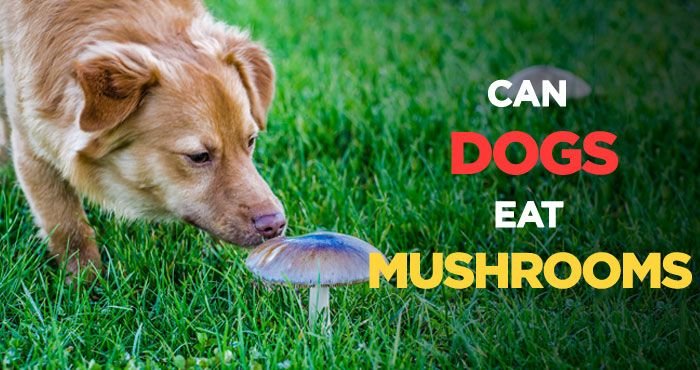The question is can dogs eat mushrooms.? “There are old mushroom trackers, there are strong mushroom trackers, yet there are no old, intense mushroom trackers.” This saying portrays how precarious mushrooms can be, particularly with regards to recognizing protected, palatable assortments for ourselves and our canine companions. Canines, while astute from multiple points of view, are not normally the most insightful with regards to what goes into their mouths. To confound matters, some poisonous mushroom species, for example, the passing cap, have an off-putting smell, which can draw in canines.
Which mushrooms are ok for dogs can dogs eat mushrooms?
Considering fusing mushrooms into your pet’s eating routine? Buy natural assortments found in a supermarket. Mushrooms adequately absorb poisons and pesticides, so natural choices will be liberated from these undesirable mixtures. Therefore, dogs can eat mushrooms.
Dogs can securely eat the accompanying kinds of mushrooms:
White catch
Cremini
Portobello
Porcini
Reishi
Shiitake
Maitake
On the off chance that you intend to add mushrooms to your pet’s eating regimen, try not to set them up in weighty sauces or flavors. Basic is ideal, or follow our pet-safe mushroom formula beneath.
Which mushrooms are harmful to dogs?
Around 100 mushroom species are considered harmful, and those are hugely poisonous. Here are a couple of the most well-known harmful species:
Amanita phalloides (demise cap).
Galerina marginata (lethal Galerina).
Amanita gemmata (jeweled demise cap).
Amanita muscaria (fly agaric).
Gyromitra species (bogus morel).
Inocybe species and Clitocybe dealbata mushrooms.
Recognizing poisonous types of mushrooms can be a test, in any event, for experienced foragers. In the event that your pet gets one during a forest hike, don’t sit around idly endeavoring to recognize the species; promptly contact your veterinarian or toxic substance control focus.
Can dogs eat mushroom and what are the medical advantages of mushrooms for dogs?
Mushrooms are packed with supplements. Adding them to your canine’s eating routine can have the following advantages:
Backing liver and kidney work.
Improve nourishment in feeble creatures.
Settle glucose and digestion.
Lower cholesterol, help weight reduction, and help in forestalling greasy liver illness.
Help forestall viral contamination.
Lift resistant framework.
Diminish circulatory strain.
Forestall coronary illness.
Forestall and fight malignancy.
What are the indications of harmful mushroom ingestion for dogs?
On the off chance that your canine burns-through a mushroom coincidentally, consider it poisonous until you’ve had the option to demonstrate something else. A few indications of poisonous mushroom ingestion include:
Salivation
Tear creation
Pee
Sedation
Quakes
Seizures
Liver disappointment
Extreme gastrointestinal bombshell
Demise
In the event that you speculate your pet has eaten a possibly noxious mushroom, quick veterinary treatment is required. When your pet strolls through the entryway, the veterinary group will attempt to free the body of the mushroom’s harmfulness, regularly by initiating retching or potentially utilizing actuated charcoal to tie the toxic substance. Your canine’s guess and recuperation time will be improved with early strong considerations that will probably incorporate IV liquids just as liver-protectant and hostile to sickness prescriptions.
A few canines might be adversely affected by mushrooms. Indications of a potential food hypersensitivity include:
Regurgitating, particularly following eating
Extreme gas
Skin issues
Furthermore, a few pets might be very touchy and have a serious response in the wake of eating mushrooms, albeit this is very uncommon. To be protected, be watching out for:
Hives
Expanding of the face or neck
Expanded pulse
Trouble relaxing.
How would you be able to add mushrooms to your pet’s diet?
Can dogs eat mushroom? Like any new nourishment for your canine, mushrooms ought to be acquainted progressively with forestall stomach upset. Gradually increment the sum you’re taking care of over a time of a few days, and stop promptly on the off chance that you notice any indications of disease. Likewise, make certain to present just a single new food at a time so you’ll have the option to distinguish the guilty party if your pet winds up with a resentful stomach.
By and large, new or dried mushrooms contain more helpful supplements than canned or protected mushrooms. Canines don’t make the catalysts expected to separate the fiber and a portion of the sugars found in mushrooms, so make certain to cook any new mushrooms prior to taking care of them to your pet to help in processing.
Prepared to begin dishing up certain mushrooms to your number one canine? Here’s a pet-accommodating mushroom formula to add to your canine’s menu:
Mushrooms and peas
(Formula acquired from Dr. Ihor Basko, all encompassing veterinarian, at drbasko.com.)
Fixings:
1/2 cup meagerly cut white catch mushrooms or porcini
1/2 cup slashed snow peas
3 tablespoons margarine or ghee
1 crude egg
Headings:
Sauté mushrooms in margarine on medium warmth for around 10 minutes.
Add stock and increment warmth to medium high.
Add snow peas and cook for an additional 5 minutes, blending admirably.
Eliminate from heat.
Air out the crude egg over the mushrooms and peas. Blend well.
Cover skillet to permit the egg to cook.
Serve at room temperature, over an equivalent measure of cooked earthy colored rice or quinoa.
Try not to sit tight for your pet to coincidentally eat a noxious mushroom. Ask your vet now which toxin control focus they suggest and keep their number convenient!
Conclusions.
With such countless innovative approaches to offer mushroom to your canine, it’s difficult to disregard mushroom as a sound expansion to your doggie nibble menu! So dogs can eat mushrooms. Follow the link to find out if what your pets eat affect pet insurance.
